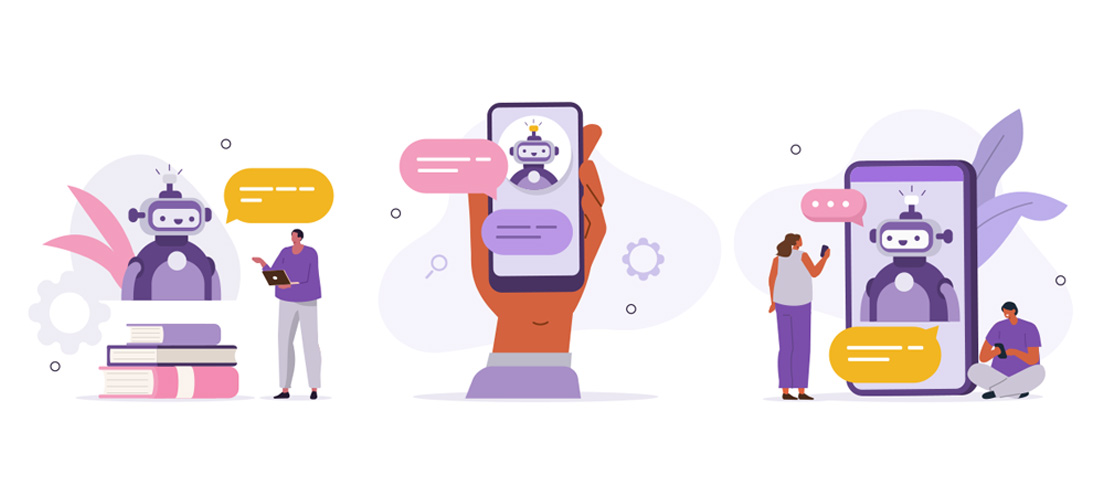New developments in artificial intelligence (AI) are dominating the headlines and the old familiar refrain about technology replacing human workers is louder than ever. This is especially true in customer service. Why don’t service providers just plug in ChatGPT and magically convert those frustrating exchanges into smooth and satisfying experiences?
Technology can certainly help, and it has been helping for a long time. But customer service delivery is a quintessentially human interaction, and even though new technologies add speed and efficiency, they can never substitute for the nuanced understanding and dynamic flexibility that human agents bring to customer service interactions.
We’ve been down this road before, in a sense; first-generation chatbots appeared in the early 2000s and many believed that they signaled the beginning of the end for human agents. Those chatbots did prove to be effective at dispatching simple transactional inquiries. But as we all know, they were helpless the minute a request involved any ambiguity. We still needed that human agent after all!
Expand the Pie
There’s a better way to think about this. It’s not about how to divide the pie—it’s about how to expand it. Rather than replace human agents, AI and other new applications will change the way customer service delivery is done. That’s not a threat. It’s an opportunity, and a great one at that. The way to get the most from this opportunity is to leverage both AI’s ability to execute the transactional and processing tasks it can do better than humans and also its ability to provide greater support that makes agents better at solving complex issues.
Automation of key contact center processes in recent years has streamlined workflow efficiency, but it hasn’t improved agents’ ability to satisfy customers once they’re connected. Why? Because they’re still handling direct customer engagement and also processing and interpreting the inputs needed to resolve customer problems.
AI can help. In a fraction of the time it takes a human agent, AI can access and process huge pools of data, identify relevant patterns, and predict the best solution to whatever problem is at hand. AI collapses the delay and inefficiency caused by limited human processing capacity, retrieving and collating critical missing information and placing it at the agent’s disposal instantaneously. This liberates agents to focus on applying nuanced judgment—a uniquely human ability—after careful assessment of options in light of the urgency of the situation, the comfort level of the customer, and other variables.
Avoid the Pitfalls of the Past
Unfortunately, some contact center leaders are repeating errors made with earlier chatbots, by viewing the current generation of AI applications as straight-on replacements for human capabilities. Predictably, this is causing a power struggles between people and machines.
The Wall Street Journal recently published an article that describes how some call centers are using machine-learning models to take decision-making responsibility away from agents—scanning conversations and recommending what agents should say or do next, based on words and sentiments expressed by customers. But agents are pushing back. In interviews across a range of companies, many said they value AI’s ability to access information quickly to help them make decisions, but object to being forced to use AI-generated scripts against their own judgment.
“It’s very hard for a robot with no emotions to truly judge how a call is going,” said one agent. Another agent joked that after repeated errors made by their center’s AI Assistant, he and his colleagues were “taking up a collection to get [the Assistant] a hearing aid.” A quick perusal of the article’s comment section makes it clear that customers aren’t fans either. They want their problems solved with the nuance and empathy that only a human can provide.
Complement Human Skills
We all want our customer service experiences to be more efficient, and AI will make it so. At the same time, we’ll never lose our primal need for reassurance at high-stakes moments. We recognize that reassurance in a firm handshake, a steady gaze, and the cadence of a confident voice. We know it when we feel it, and we know it when we don’t. AI may get there one day, but until it does, we should focus on leveraging its enormous potential to complement our finely-honed intelligence rather than replacing it.
As AI continues to mature, contact centers should continue to route transactional and computational tasks to chatbots and reserve more complex requests for human agents. They should leverage AI to provide stronger support to help agents manage those higher-stakes interactions—support that will come from applications specifically designed to streamline training, coaching, time and stress management, and other steps to boost agents’ skills and well-being.
My company is developing an AI-based solution to help reduce the financial and personnel impacts of attrition. Our goal is to allow for early identification and intervention to prevent agent burnout and promote well-being and engagement. This will save organizations a lot of money and provide guidance to help managers support their agents more effectively.
This is how AI should fit into customer service. Not as a bloodless virtual agent, but as a highly effective support tool to make human agents better at satisfying the needs of human customers. People will always play the decisive role in customer service—a domain where promises to deliver outcomes or rectify mistakes are always premised on a bedrock of faith. And despite AI’s formidable ability to fill in the gaps of our deficiencies, there’s still no algorithm for faith.

Guest blog post written by Intradiem.
To learn more about this topic and others, join us in Nashville for Customer Response Summit (CRS) on September 20-22, 2023.




























































 TELUS Digital
TELUS Digital ibex delivers innovative BPO, smart digital marketing, online acquisition technology, and end-to-end customer engagement solutions to help companies acquire, engage and retain customers. ibex leverages its diverse global team and industry-leading technology, including its AI-powered ibex Wave iX solutions suite, to drive superior CX for top brands across retail, e-commerce, healthcare, fintech, utilities and logistics.
ibex delivers innovative BPO, smart digital marketing, online acquisition technology, and end-to-end customer engagement solutions to help companies acquire, engage and retain customers. ibex leverages its diverse global team and industry-leading technology, including its AI-powered ibex Wave iX solutions suite, to drive superior CX for top brands across retail, e-commerce, healthcare, fintech, utilities and logistics.






















 Trista Miller
Trista Miller




























